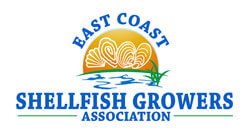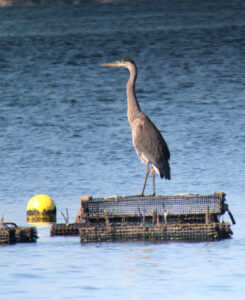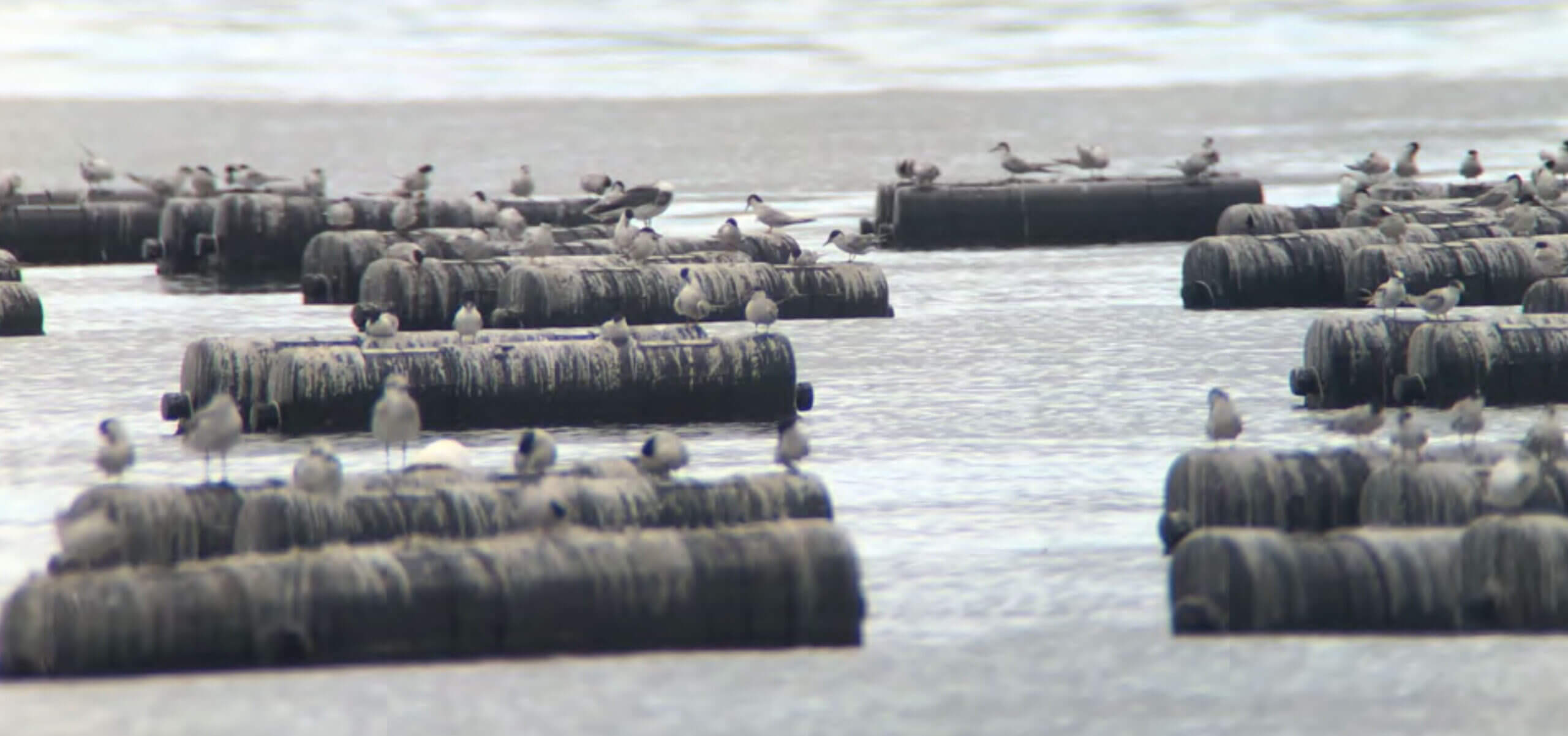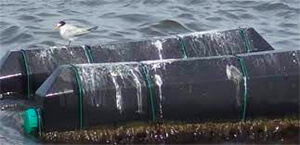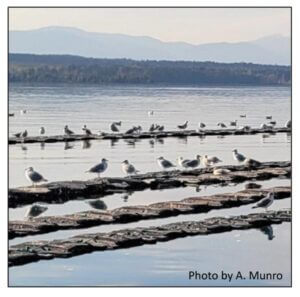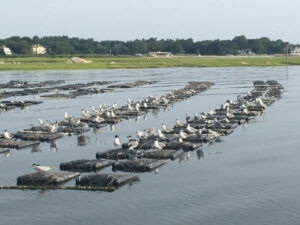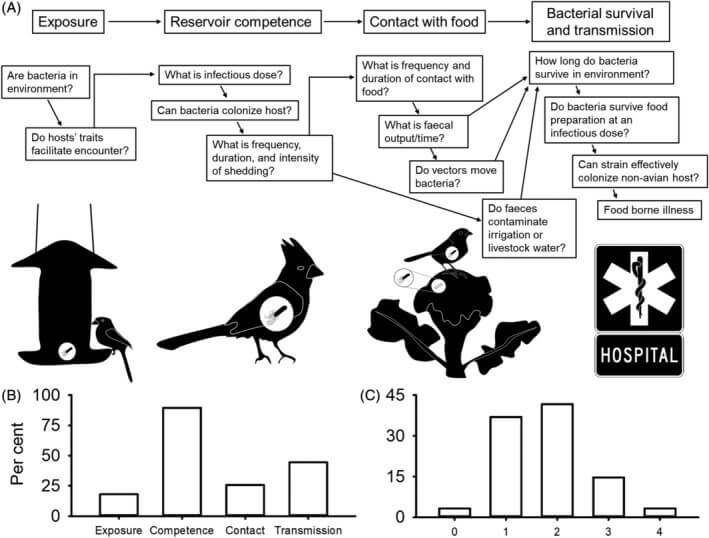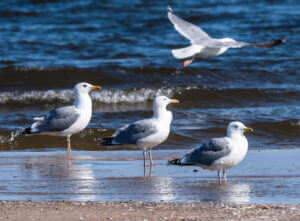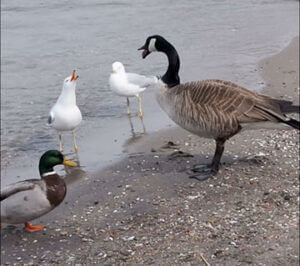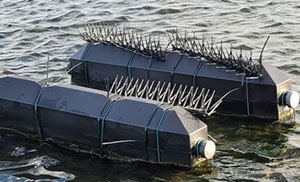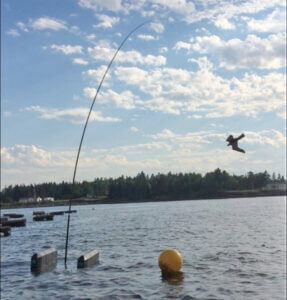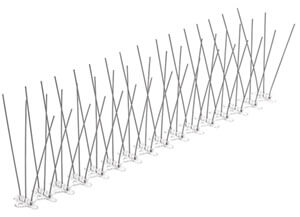Bird Interactions with Shellfish Gear
Our bird interaction resources are listed below as links to callouts for pages, videos or documents.
Each callout has a brief description of the resource and a title or photo that links to the resource.
Shellfish Sanitation and Birds (Aquaculture Information Exchange video)
Shellfish Sanitation and Birds (Power Point video)
Birds and Shellfish Sanitation session of 115th NSA meeting (notes on 11 presentations)
Birds on Floating Culture, Oh My! (pdf of Power Point from 115th NSA meeting
Deterring Birds (SEMAC pdf of Power Point)
Fact sheet on Potential for Food-borne Illness Caused by Bird Waste (pdf)
Birds on Floating Gear Could Present Problems (ECSGA newsletter article pdf)
Notes on Bird Interactions with Shellfish Gear webinar (pdf)
Shellfish Sanitation and Birds
This 54-minute video of Executor Director Bob Rheault's July 2024 presentation for the Aquaculture Information Exchange on how birds like cormorants can pose health risks and economic challenges to shellfish and fish farming. He highlighted the varying responses from state authorities regarding the mitigation of bird waste and its health risks, and shared different deterrence methods being tested, such as scare kites and bird spikes. The session emphasized the importance of continuing research and collaboration to address these challenges while advocating for regulatory clarity and support from the aquaculture community.
Shellfish Sanitation and Birds
This 13-minute video of Executor Director Bob Rheault's April 2024 Power Point presentation reviews the issues related to floating gear, water fowl and shellfish sanitation. In it he highlights the formation of a new committee under the ISSC, the Guano Abatement Committee.
Seasonal Patterns of Distribution and Abundance of Waterbirds in Relation to Oyster Aquaculture in Coastal Rhode Island
Dr. Martina Muller of the University of Rhode Island's Department of Natural Resource Sciences presented this Powerpoint at the 115th annual meeting of the National Shellfisheries Association in Baltimore, Maryland, in March 2023. She also took notes on all 11 presentations for the BIrds and Shellfish Sanitation Session at that meeting.
Birds and Shellfish Sanitation session of NSA conference
Notes on the 11 presentations given at the Birds and Shellfish Sanitation session at the 115th annual meeting of the National Shellfisheries Association in Baltimore, Maryland, in March 2023. Courtesy of Caitlin Randall of the University of Rhode Island's Department of Natural Resource Sciences.
Deterring coastal birds from roosting on oyster culture gear in eastern New Brunswick, Canada
This paper by L.A. Comeau, et al., from the March 2009 issue of Aquacultural Engineering is one of the first studies on the subject. The authors presented possible mitigation measures to prevent roosting. Their results suggested for floating bags, floater instability coupled with an immersion depth of approximately 6 cm (for the bag itself) were effective deterrents to birds.
Birds on Floating Culture, Oh My!
This slide show from the 115th annual meeting of the National Shellfish Association (NSA) was presented by Bobbi Hudson, Director of the Pacific Shellfish Institute, in March 2023.
SEMAC Presentation on Bird Deterrents
The Southeastern Massachusetts Aquaculture Center on Cape Cod is in the process of conducting studies examining bird deterrents on aquaculture sites. This pdf exported from a power point presentation illustrates some of their imaginative solutions, but many approaches need more work and refinement. With wide variability among locations, seasons and species, you may need multiple deterrents to avoid birds' acclimating to your site. Many sites show strong seasonality, so birds are only a problem for a few weeks a year. More research is planned for the 2022 growing season.
Are We Overestimating Risk of Enteric Pathogen Spillover From Wild Birds To Humans?
In this 2021 paper by Olivia M. Smith, William E. Snyder and Jeb P. Owen the authors note that despite numerous studies of enteric bacteria in wild birds, and policies to discourage birds from food systems, we lack a comprehensive understanding of wild bird involvement in transmission of enteric bacteria to humans. they propose a framework for understanding spillover of enteric pathogens from wild birds to humans.
Note: ECSGA Executive Director Bob Rheault highlighted the salient points in this pdf.
EPA Technical Support Materials: Developing Alternative Recreational Criteria for Waters Contaminated by Predominantly Non-Human Fecal Sources
Campylobacter jejuni in Black-Headed Gulls: Prevalence, Genotypes, and Influence on C. jejuni Epidemiology
Campylobacteriosis is a zoonotic disease in which birds have been suggested to play an important role as a reservoir. In this paper by T. Broman et al., which appeared in the December 2002 Journal of Clinical Microbiology, the authors examined the prevalence and nature of Campylobacter jejuni in black-headed gulls (Larus ridibundus) in Malmo in southern Sweden. They concluded that because the majority of isolates found among wild birds differed in genotype from those commonly isolated from humans, gulls in Malm may function more as accidental vehicles rather than as a true reservoir of C. jejuni lineages important for clinical disease in humans.
Note: ECSGA Executive Director Bob Rheault highlighted the salient points in this pdf.
Fact Sheet on Potential for Food-Borne Illness Caused by Bird Waste
The information in this fact sheet from Cape Cod Cooperative Extension (CCE) is based on a review of scientific articles on the topic of food safety impacts that bird waste may have on shellfish production. CCE has been working with a Master of Public Health student to better understand the risk from birds roosting on floating gear, in hopes that solutions can be found. With a recent report of human illnesses from Campylobacter tied to consumption of cultured oysters, this concern is likely to grow, and has regulatory agencies concerned about the potential for bird waste impacting human health.
Birds on Floating Gear Could Present Problems
This article from the December 2021 ECSGA newsletter describes some of the issues related to birds landing on floating shellfish gear, as well as some solutions in the pipeline.
Bird Interactions With Shellfish Gear Webinar
Read ECSGA Executive Director Bob Rheault's summary of a Feb. 17, 2021 webinar hosted by the U.S. Fish and Wildlife Service on issues relating to birds and aquaculture.
Birdbgone.com
For more ideas, visit Birdbgone.com and check out their large variety of bird deterrent products.
